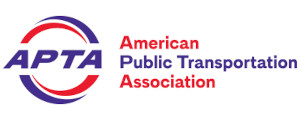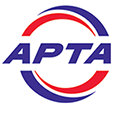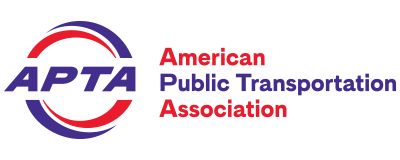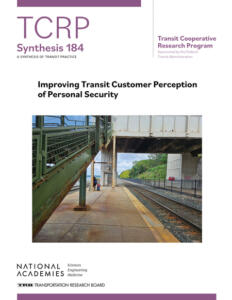
Improving Transit Customer Perception of Personal Security
Report Number: S-184
Publication Date: 10/30/2025
Ensuring the safety and security of customers is a core responsibility of public transit agencies. Perceptions of personal safety play a critical role in influencing travel behavior, with fear and anxiety about personal safety acting as major deterrents to transit use.
This report documents the current state of the practice related to customer perceptions of safety and security on bus and rail transit. Drawing from a literature review, a national survey of 35 transit providers, and in-depth case examples of five transit providers, this synthesis highlights strategies to improve customers’ outlook, the effectiveness of those strategies, how the strategies are communicated to the public, and the associated change in customers’ perceptions.
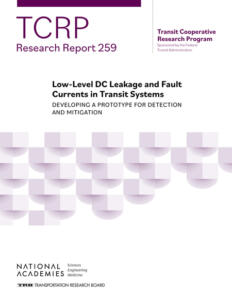
Low-Level DC Leakage and Fault Currents in Transit Systems: Developing a Prototype for Detection and Mitigation
Report Number: R-259
Publication Date: 10/23/2025
Low-level electrical fault currents are a phenomenon found in direct current (DC) traction systems used in public transit systems worldwide. These low-level currents are typically caused by small and sporadic failures of insulation within the electrification system, which makes them difficult to locate, measure, and control. If these faults are left undetected, existing evidence shows extensive damage to infrastructure of transit systems and that of adjacent private/public utilities could result.
This report develops a prototype system that can detect low-level faults in electrified transit systems powered by third rails.
The report is supplemental to TCRP Research Report 211: Guidebook for Detecting and Mitigating Low-Level DC Leakage and Fault Currents in Transit Systems.
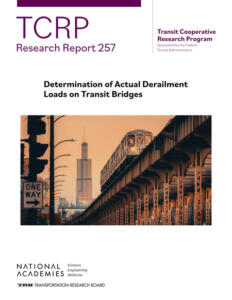
Determination of Actual Derailment Loads on Transit Bridges
Report Number: R-257
Publication Date: 10/23/2025
Derailment loads in nearly all U.S. transit design criteria documents are similar across agencies. However, it is unclear whether horizontal and vertical derailment loads for the efficient and safe design of transit structures are reasonably accurate.
This report provides the transit industry with a reasoned basis for derailment loads on bridges. It also offers methodologies that bridge design engineers can utilize to calculate the horizontal and vertical derailment impact loading.
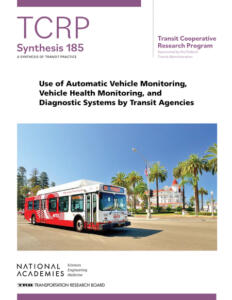
Use of Automatic Vehicle Monitoring, Vehicle Health Monitoring, and Diagnostic Systems by Transit Agencies
Report Number: S-185
Publication Date: 10/13/2025
Automatic vehicle monitoring (AVM) and vehicle health monitoring (VHM) are becoming more widely utilized by transit agencies across the United States. These agencies are increasingly interested in using predictive maintenance technology (PMT), artificial intelligence (AI), and other technologies, but the overall capabilities and benefits of these technologies are still emerging.
This report explores how AVM, VHM, and other technologies are utilized to monitor an array of onboard vehicle components in order to assist in the early identification of potential mechanical issues, thus supporting effective maintenance practices.
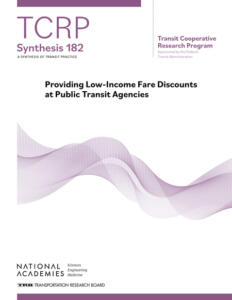
Providing Low-Income Fare Discounts at Public Transit Agencies
Report Number: S-182
Publication Date: 09/24/2025
Over the past decade, public transit agencies across the United States and Canada have increasingly adopted low-income fare discount programs to improve transit affordability and accessibility. The COVID-19 pandemic accelerated this trend, prompting agencies to reevaluate services and expand affordable transit choices. These programs offer various benefits such as fare discounts, free rides, or discounted passes.
This report documents the current state of the practice of low-income fare discount programs offered by North American transit agencies.
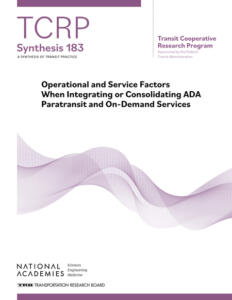
Operational and Service Factors When Integrating or Consolidating ADA Paratransit and On-Demand Services
Report Number: S-183
Publication Date: 09/10/2025
Demand response transportation (DRT) providers have consistently looked for operational designs and mechanisms to improve service efficiencies and lower operational costs. DRT services, which include ADA (Americans with Disabilities Act) complementary paratransit and general public DRT services, such as advance reservation dial-a-ride services and ondemand microtransit services, are inherently less efficient to operate due to circumstances of geography, population locations, program rules, and “points of interest” (relevant transit locations and destinations) for travel.
This report provides information, analysis, and examples of the current state of the practice in integrating or consolidating ADA paratransit and other types of paratransit service with on-demand microtransit for the general public, including documented findings and results from the agencies, municipalities, and other local government entities providing these commingled trips.
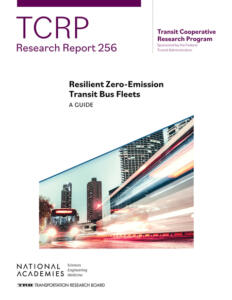
Resilient Zero-Emission Transit Bus Fleets: A Guide
Report Number: R-256
Publication Date: 09/10/2025
